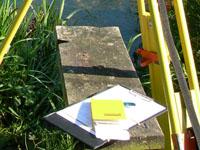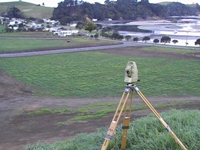
You are here
Common Questions
New Zealand Qualified Surveyors have been trained in a variety of fields. These include Cadastral (Land Title) Surveying, Civil Engineering, Land Law, Planning, Measurement Science, Geographic Information Systems, Industrial Measurement, Earth Deformation Measurement, Hydrographic Surveying, and Cartography (Map Making). Most Surveyors then tend to specialize into some of these fields. For example, our business primarily undertakes Cadastral Surveying, Planning and some Civil Engineering work. These also require a reasonable knowledge of New Zealand Land Law. We have undertaken surveys to monitor buildings (for deformation) and monitor settlement of earthworks, stockpile measurements to determine volumes, and providing expert witness evidence for measurements in the District Court.
There are a number of options depending on what capacity the surveyor fulfils. Some people begin by working for a survey firm for a period of time learning certain generic tasks and becoming very proficient in these. Such a person might be called an unqualified technician. Unitec, in Auckland, provides formal survey technician training. People so qualified are able to undertake many of the tasks undertaken within a survey firm, particularly after accumulating a reasonable period of practical experience. However, they are unable to certify their work and are reliant upon a Registered Surveyor (an older term), or a Licensed Cadastral Surveyor to do this for them. This person is required to have completed the Bachelor of Surveying Degree, which is obtained after four successful years of study at the University of Otago. This is then followed by at least two years of practical experience under a Registered or Licensed Cadastral Surveyor. There is a requirement to demonstrate competence to the Survey Board with the presentation of suitable projects, and passing the obligatory Law Exam. Links to Unitec and The Surveying Department of the University of Otago can be found in this website.
We are often asked what is involved in undertaking the subdivision of a property. The following is a generic listing of steps that may be required. Not all of these may be relevant to a particular project and you should consult with your surveyor regarding your project.
A scoping exercise is undertaken to determine what the potential subdivider wishes to achieve. Relevant land information is searched to determine what elements make up the property and may affect the subdivision.
The subdivider's aspirations are examined with respect to the rules and regulations set out in the District Plan, together with the Objectives and Policies of the District Plan to determine how to best present the application to the District Council. (This can sometimes be like trying to fit a square peg into a round hole!!)
The application is prepared, together with any additional reports and evidence to support the application.
Some applications require the written consents of affected parties. These are often the neighbouring landowners.
The application is lodged with the District Council. Council has twenty working days to process the application. However, the Resource Management Act allows the Council to double this timeframe. In recent times the local authorities have not been able to achieve these timeframes. Staffing shortages and the number of applications being lodged with the Council have been cited as the main reasons for the extended timeframes.
The Council can choose, at its discretion, to notify an application, either publicly or to a limited number of parties deemed by the Council to be affected. The notification period is generally one month. However, the Local authority can extend this period if they consider that more time is warranted.
At the conclusion of the notification period, the Council examines any submissions that were received. If there are submissions received that oppose the application, then the application will be heard by Council's Judicial Committee. Should Council's planner not support the application, then this will also cause the application to be heard by the Judicial Committee.
The applicant and any submitters have the opportunity to present their case at the Judicial Committee Hearing. The Councillors may also wish to ask questions of the parties concerned to enable them to better understand the application.
The Council's decision on the application is usually notified to all parties concerned within three weeks of the hearing. The decision can be the subject of an objection within fifteen working days of the notice being received. It is also possible to appeal decisions to the Environment Court. The majority of applications that we undertake are resolved without the need for Judicial Committee hearings or appeals to the Environment Court.
Council is likely to impose conditions upon granting a subdivision consent. These will vary depending on the complexity of the subdivision and the environmental effects perceived by the Council. Conditions may include: providing adequate access and servicing; providing easements where necessary; providing consent notices regarding conditions that are to be dealt with on an ongoing basis; providing conservation covenants if required and fencing of these. These conditions need to be satisfied before a subdivider can be issued with new titles.
In some cases the Council may require a Civil Engineering design of access and services for the subdivision. This is often presented to the Council as a set of plans showing various items such as the geometrical shape and design of bulk earthworks, road extensions, private accesses, and piped services such as stormwater and effluent disposal systems. The plans may also include water reticulation extensions, including water mains, pumping stations, valves and hydrants.
Council may also impose Development Contributions, which will need to be paid before the Council will issue the conditions certificate for the subdivision.
The new subdivision boundaries must be pegged where they have not previously pegged, and a survey dataset prepared for lodgment with LINZ.
The title sheet of the survey plan is to be certified by the Council. The Resource Management Act 1991 provides for a time of up to five years from the date that the Council issues the subdivision consent until the title sheet is to be certified by Council. The subdivider can proceed at any stage during this time. The plan is also to be approved by the land owners concerned.
Once these matters have been finalised the dataset can be lodged with LINZ for approval as to survey.
The Resource Management Act 1991 gives the subdivider three years from the date that the title sheet is certified by the Council until the titles are issued. This means that the conditions imposed by the Council have to be satisfied to the Council's satisfaction, the Council issues the conditions certificate, and the subdivider's solicitor applies for the new titles, together with the registration of other documents such as easements.
Often it is possible to have several parts of the subdivision process occurring at the same time. For example, the subdivider may undertake some access improvements while the surveyors are undertaking the Legal survey work, and while the subdivider's solicitor is preparing some of the legal documents associated with the subdivision.
There are many components of a subdivision. These components may include location and size of the lots, the terrain, and the planning rules affecting the land, the proximity of services to the property and whether these have sufficient capacity to serve the subdivision. Every subdivision differs with respect to the number of and make up of its components. Most of these components have a cost implication. A surveyor can undertake the necessary research to determine the likely costs of the project. We can provide a reasonably accurate estimate of our fees when the scope of the project is clearly defined.




